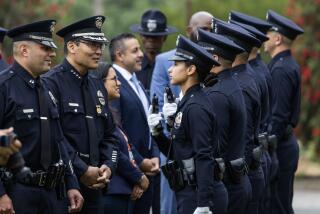National Guard Struggles With Lean Budgets
SACRAMENTO — They call themselves “America’s Army,” and it fits, for they come from our workaday ranks. That guy who changes your car’s oil might command a tank on weekends. Or maybe your boss trades her high heels and power suit once a month for military garb and a gun.
But the weekend warriors of the National Guard are hurting.
Faced with lean budgets in a post-Cold War world, the National Guard finds itself struggling along with the rest of the country’s military monolith.
Nowhere is the concern so great as in California, where the Guard has been pressed into homeland service repeatedly over the past decade for disasters both natural and human-made. From last year’s Northern California floods to the Los Angeles riots and the Laguna firestorm, the Guard has helped the state in times of need.
That aid might soon be harder to come by.
At the state’s 40th Infantry Division, based in the Orange County suburb of Los Alamitos, there is grim talk of a 66% cut in weekend field training, of few spare parts for Humvees and trucks, of limited fuel for tanks, of aircraft grounded for lack of repairs.
Such shortfalls will eventually hurt the Guard’s ability to act as a well-prepared backstop for the regular Army in the event of war, commanders say. And with fewer opportunities to train, commanders worry that some of the California division’s 14,000 citizen-soldiers will turn sour and bolt, thinning the ranks.
“These kids joined the National Guard to drive tanks, shoot guns, fire artillery pieces,” said Brig. Gen. Edmund Zysk, the division’s commander. “If they don’t have that weekend diversion, they’re going to vote with their boots. They’re going to walk.”
The budgetary cutbacks could have other consequences, perhaps curbing the Guard’s ability to respond at a moment’s notice to disasters in California. With a harsh winter expected because of El Nino, Guard commanders insist that they are locked and loaded for any emergency the storms can dish out. But it could be tougher to handle such contingencies in the years to come, and that has state officials concerned.
“If this trend continues, it’s going to be more difficult for them to respond,” said Troy Armstrong, operations chief at the California Office of Emergency Services, which shepherds the state’s disaster efforts. “They have to move fast in a state disaster. And they’re losing a little of that ability each year. The cuts have been dramatic.”
In California, the Guard has seen its overall budget sliced by 25% over the past five years. Funds for vehicle repairs, critical in maintaining readiness for state disasters, have been slashed by nearly three-quarters since 1992.
One need look no farther than the Guard’s Santa Ana armory, where the 4th Battalion 160th Infantry mechanized unit struggles to keep running. Of the 35 Humvees assigned to the battalion, 13 are working. The rest await parts that can’t be bought because of a lack of funds; some have been sitting for as long as a year.
*
The problem can be even more dire with the Guard’s new generation of fighting machines, which are far more expensive to repair than their predecessors.
“Without equipment, we can’t move,” said Master Sgt. Walter Bruyn, the battalion’s operations and training chief. “It’s scary. If there were civil unrest right now, we’d have to car-pool to the riot site.”
In the meantime, Bruyn and his comrades in the California National Guard have been operating on guile and Band-Aid. “We pick ourselves up by the bootstraps,” he said. “There’s a lot of creative ways we keep doing business.”
With no money to hire private buses or pay for gas to ferry troops to the Guard’s main training grounds in central California, members pile into their civilian cars and vans. To save money and a long drive, Bruyn’s Santa Ana-based battalion has piggybacked with the Marines to train at nearby Camp Pendleton.
Elsewhere it’s the same story. If spare parts are wanting, downed vehicles are cannibalized. For communications during training, some units tote their personal cell phones. A few soldiers go beyond the call of duty and pull out their family credit cards to fuel up military vehicles at civilian gas pumps.
The 80-member Guard unit that recently left Southern California for Bosnia had to borrow their gas masks from another team because their own were antiquated.
Guard leaders are trying to help. With money short for artillery, they’ve purchased sophisticated electronic simulators that can turn a tank or other armored vehicle into a rolling video arcade, complete with imaginary enemy in the periscope sight and scorecard of hits and misses from the big gun. But it doesn’t replace the real thing--the feel of artillery exploding out of the barrel, the noise, the tension.
Maj. Gen. Robert J. Brandt, the California National Guard’s assistant adjunct general, said he hasn’t seen it so lean, not even in the down years after the Korean War and Vietnam. Although the Guard’s ability to serve in wartime and domestic disaster remains intact, he said, it won’t stay that way if the downward financial spiral continues.
“When they cut off the blood, it takes a while for the muscles to atrophy and finally succumb,” Brandt said. “Right now, we’re just robbing Peter to pay Paul. But when there’s no longer money to buy spare parts for helicopters and Humvees, it’s going to have a detrimental effect on the state mission.”
It could also cause problems at times of war, Brandt said, a problem he thinks the country could avoid if it would just pay heed to its own history. Before World War II and the Cold War, the United States tended to ratchet down its active-duty forces in peacetime and boost the numbers in the National Guard and military reserves.
*
Army forces have fallen dramatically since the end of the Cold War in 1989, with the number of soldiers down from nearly 800,000 to less than 500,000. But the National Guard hasn’t ballooned to offset it, instead falling from about 500,000 personnel nationwide to 400,000 today.
Brandt says boosting the Guard and reserves would be a cheap way to maintain national security as the military dollar shrinks. Unlike active-duty soldiers, who are paid to serve 365 days a year, Guard members are reimbursed only for the one weekend a month and one week a year that they report. The rest of the time they’re like any other civilian, paying their own way through life.
But officials in the Army say the world has changed, and the military structure has had to shift with it. With potential hot spots scattered around the globe, from the Saudi sands to the demilitarized zone of Korea, the Army can’t reduce its active duty forces much more without putting the country’s interests in jeopardy. Although the Guard is integral, active-duty forces are needed to strike quickly when trouble flares.
The Army brass oversees the National Guard budget, and the relationship hasn’t been cozy. By most accounts, the National Guard and Army have been tussling over funding and staffing since at least the War of 1812.
“There has been a historical conflict,” said Col. Stephen Cook, the Army’s deputy director overseeing the Guard and reserves. “We need to build more trust and confidence between all the forces, but a 200-year-old conflict isn’t going to be solved overnight.”
Cook also noted that the Guard’s 11% share of the Army budget is actually a bigger piece than it was in 1989, when it got less than 9%. Instead of squabbling, he said, the National Guard, the Army reserves and regular Army should work in unison to push lawmakers for a bigger piece of the budget pie.
So far that hasn’t happened. Instead, the Guard has turned to the halls of Congress for relief. It has maintained an aggressive lobbying effort in Washington, but with only limited success.
“There is a big fight in the defense establishment over what the Guard’s role should be, and mostly the Guard has come up short,” said Lee Halterman, Democratic counsel to the House National Security Committee. “Our view is we can save a lot of money by better using the Guard. Especially with the end of the Cold War, it makes sense to not have a large standing army and rely more on state militias.”
Even as the Army and Guard continue their fraternal feud, relief could be coming to California. There is talk of funding a top-tier National Guard fighting force, known as an enhanced brigade, in California. The elite brigade would be better funded and equipped, giving the state a ready arm for the most critical emergencies.
But it won’t come for at least a couple of years, if ever. And it could be too little too late.
“The National Guard has historically been this country’s insurance policy, which has paid off in every national emergency we’ve had,” said Brandt from the California National Guard. “Now we’re letting it lapse.”
(BEGIN TEXT OF INFOBOX / INFOGRAPHIC)
Slimming the Guard
Since 1993, the California Army National Guard--has seen its ranks dwindle and its budgets for operations and repairs slashed. The fiscal year trends:
* Personnel
1993: 19,400
1998: 16,700*
* Operations Budget
(millions)
1993: $205.5
1998: 155.0*
* Repair Budget
(millions)
1993: $10.1
1998: 2.6*
* Anticipated total
Here is how the 1993-98 changes compare on a percentage basis:
Personnel: -14%
Operations budget: -25
Repair budget: -74
Source: California Army National Guard; Researched by ERIC BAILEY/Los Angeles Times


